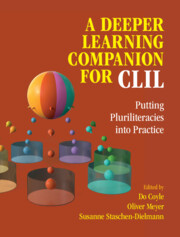Book contents
- A Deeper Learning Companion for CLIL
- A Deeper Learning Companion for CLIL
- Copyright page
- Contents
- Tables
- Figures
- Contributors
- Preface
- Part I Key Ideas and Principles of Pluriliteracies Teaching for Deeper Learning
- Part II Deeper Learning Episodes: First Steps towards Transforming Classrooms
- 5 Chemistry: Exploring Pluriliteracies through a Deeper Learning Episode on Redox Reactions
- 6 Physics: Exploring Pluriliteracies through a Deeper Learning Episode on Rainbows
- 7 Geography: Exploring Pluriliteracies through a Deeper Learning Episode on Global Warming
- 8 History: Exploring Pluriliteracies through a Deeper Learning Episode on the German Empire
- 9 Political Science: Exploring Pluriliteracies through a Deeper Learning Episode on Electronic Waste
- 10 Modern Languages: Exploring Pluriliteracies through a Deeper Learning Episode in French Literature with Younger Beginner Learners
- 11 Religious Education: Exploring Pluriliteracies through a Deeper Learning Episode on Modern-Day Prophets
- 12 Music: Exploring Pluriliteracies through a Deeper Learning Episode on ‘The Wellerman’
- 13 Deeper Learning Mathematics
- References
6 - Physics: Exploring Pluriliteracies through a Deeper Learning Episode on Rainbows
from Part II - Deeper Learning Episodes: First Steps towards Transforming Classrooms
Published online by Cambridge University Press: 04 February 2023
- A Deeper Learning Companion for CLIL
- A Deeper Learning Companion for CLIL
- Copyright page
- Contents
- Tables
- Figures
- Contributors
- Preface
- Part I Key Ideas and Principles of Pluriliteracies Teaching for Deeper Learning
- Part II Deeper Learning Episodes: First Steps towards Transforming Classrooms
- 5 Chemistry: Exploring Pluriliteracies through a Deeper Learning Episode on Redox Reactions
- 6 Physics: Exploring Pluriliteracies through a Deeper Learning Episode on Rainbows
- 7 Geography: Exploring Pluriliteracies through a Deeper Learning Episode on Global Warming
- 8 History: Exploring Pluriliteracies through a Deeper Learning Episode on the German Empire
- 9 Political Science: Exploring Pluriliteracies through a Deeper Learning Episode on Electronic Waste
- 10 Modern Languages: Exploring Pluriliteracies through a Deeper Learning Episode in French Literature with Younger Beginner Learners
- 11 Religious Education: Exploring Pluriliteracies through a Deeper Learning Episode on Modern-Day Prophets
- 12 Music: Exploring Pluriliteracies through a Deeper Learning Episode on ‘The Wellerman’
- 13 Deeper Learning Mathematics
- References
Summary
The physics chapter by Klaus Wendt, Andreas Pysik and Johannes Lhotzky aims at promoting deeper understanding of the complex phenomenon of the rainbow and encourages learners to demonstrate and share their understanding through a Wikipedia article. In this deeper learning episode, learners carry out a number of experiments on spectral colours and colour sequences. They organise the information gathered and explain the physics concepts and processes underlying the phenomenon. The authors use innovative ways of scaffolding academic language development to increase the meaning-making potential of younger learners.
Keywords
- Type
- Chapter
- Information
- A Deeper Learning Companion for CLILPutting Pluriliteracies into Practice, pp. 49 - 96Publisher: Cambridge University PressPrint publication year: 2023

